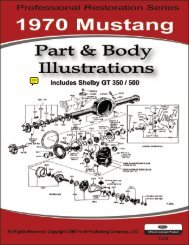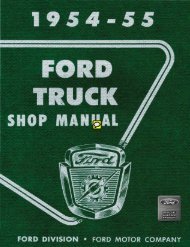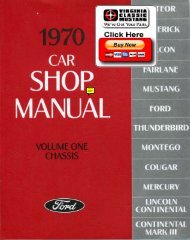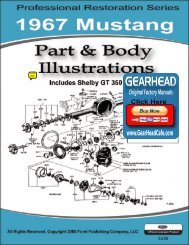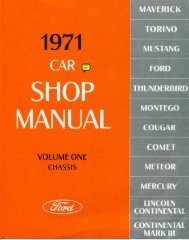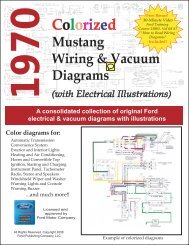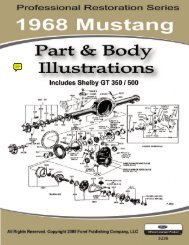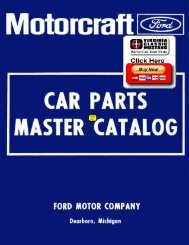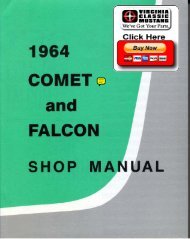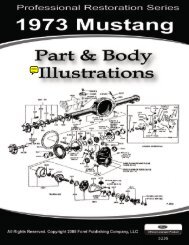DEMO - 1965 Ford Truck Shop Manual - ForelPublishing.com
DEMO - 1965 Ford Truck Shop Manual - ForelPublishing.com
DEMO - 1965 Ford Truck Shop Manual - ForelPublishing.com
You also want an ePaper? Increase the reach of your titles
YUMPU automatically turns print PDFs into web optimized ePapers that Google loves.
2-2 GROUP 2 - BRAKES<br />
DIAGNOSIS GUIDE—STANDARD HYDRAULIC BRAKES<br />
BRAKES DO NOT APPLY<br />
shoes are serviced. A defective check<br />
valve can cause a loss of residual<br />
pressure in the system causing air to<br />
enter at the wheel cylinder piston,<br />
Bleed the system to remove air from<br />
the lines, and adjust the brakes. Refill<br />
the master cylinder reservoir with<br />
heavy-duty brake fluid. If the brakes<br />
do not apply after making these<br />
checks and adjustments, fluid may be<br />
leaking past the piston cups in<br />
the master cylinder or brake wheel<br />
cylinder(s). If the trouble is in the<br />
master cylinder or brake wheel cylin-<br />
der(s), remove and repair.<br />
If the brake pedal travels all the<br />
way down to the floor without noticeable<br />
brake action, check the brake<br />
fluid level in the master cylinder reservoir.<br />
Refill the reservoir if necessary.<br />
Check the entire hydraulic system<br />
for fluid leaks, and make the<br />
necessary adjustments.<br />
If the brake pedal feels spongy<br />
when pushed down, air has entered<br />
the hydraulic lines. Air can enter the<br />
lines if the fluid level in the master<br />
cylinder reservoir is too low, or if the<br />
brake wheel cylinder pistons are not<br />
held firmly in place when the brake<br />
EXCESSIVE PEDAL TRAVEL<br />
Check for air in the brake lines<br />
and bleed the system if necessary. Ad-<br />
just or reline the brakes as needed,<br />
UNEVEN NOISY,<br />
GRABBING, OR HARD<br />
OPERATING BRAKES<br />
shoe adjustment; warped or mis-<br />
aligned shoes; webs glazed or greasy<br />
linings; and incorrectly ground or<br />
wrong linings, are a few of the causes<br />
for uneven, noisy, pulling, grabbing,<br />
or hard brakes. Adjust or replace the<br />
parts as needed to eliminate the<br />
trouble. Lining glaze can be removed<br />
by rubbing the lining with mediumgrade<br />
sandpaper until the lining has<br />
a dull finish.Always adjust the brakes<br />
after correcting any of these brake<br />
troubles.<br />
Remove the brake drums so that a<br />
<strong>com</strong>plete inspection of the brake assemblies<br />
can be made to determine<br />
the cause of the trouble.<br />
Excessive dust and dirt in the<br />
brake lining rivet holes or in the<br />
brake drum can cause brake squeal.<br />
Remove the dirt with a scraper and<br />
an air hose.<br />
Drums which are out-of-round or<br />
loose at the hub; frozen master cylinder<br />
or brake cylinder piston(s); defective<br />
check valve; improper brake<br />
BRAKES DO NOT<br />
RELEASE<br />
Check for an improperly adjusted draulic system with clean denatured<br />
brake pedal, a restricted by-pass port alcohol before adding new brake<br />
in the master cylinder, or swollen fluid.<br />
master cylinder piston cups. Check If the trouble is in the master cylfor<br />
a defective check valve restricting inder, remove and rebuild the cylfluid<br />
passing through the system. inder.<br />
Check for sticking brake cylinder If the truck must be moved when<br />
pistons caused by dirty or contami- the brakes are locked, open a brake<br />
nated brake fluid. cylinder bleeder screw for a moment<br />
Adjust the brake pedal if necessary. to let out a few drops of brake fluid.<br />
If the adjustment does not correct the This operation will release the brakes<br />
trouble, check the condition of the but will not eliminate the cause of<br />
brake fluid. Replace dirty or contam- the trouble.<br />
inated fluid. Clean the entire hy-<br />
PRELIMINARY TESTS—POWER<br />
BRAKES<br />
With the engine stopped, eliminate<br />
all vacuum from the system by<br />
pumping the brake pedal several<br />
times. Then push the pedal down as<br />
far as it will go, and note the effort<br />
required to hold it in this position. If<br />
the pedal gradually moves downward<br />
under this pressure, the hydraulic<br />
system is leaking and should<br />
be checked by a hydraulic pressure<br />
test.<br />
With the brake pedal still pushed<br />
down, start the engine. If the vacuum<br />
system is operating properly,<br />
the pedal will move downward. If<br />
the pedal position does not change,<br />
the vacuum system is not operating<br />
properly and should be checked by<br />
a vacuum test.<br />
VACUUM TESTS<br />
CHECK VALVE TEST<br />
Disconnect the line from the bottom<br />
of the vacuum check valve, and<br />
connect a vacuum gauge to the




